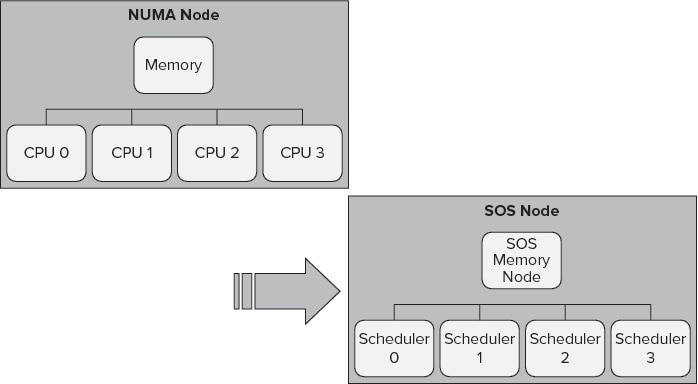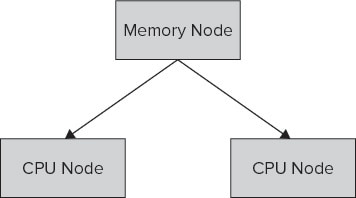(Note: This is Part 2 of a two-part article; read Part 1 here.)
The goal of this environment is to empower the SQL Server platform to exploit all of today’s hardware innovation across the X86, X64, and IA64 platforms. SQLOS was built to bring together the concepts of data locality, support for dynamic configuration, and hardware workload exploitation. This architecture also enables SQL Server 2012 to better support both Cache Coherent Non-Uniform Memory Access (CC-NUMA), Interleave NUMA (NUMA hardware with memory that behaves like an SMP system), Soft-NUMA architecture (registry-activated, software-based emulated NUMA architecture used to partition a large SMP system), and large SMP systems, by affinitizing memory to a few CPUs.
The architecture introduces the concept of a memory node, which is one hierarchy between memory and CPUs. There is a memory node for each set of CPUs to localize memory and its content to these CPUs. On an SMP architecture, a memory node shares memory across all CPUs, whereas on a NUMA architecture, a memory node per NUMA node exists.As shown in Figure 1 below, the goal of this design is to support SQL Server scalability across all hardware architectures by enabling the software to adapt to or emulate various hardware architectures.

Figure 1. Concept of memory nodes
For the purposes of this discussion, schedulers manage the work executed on a CPU.
Memory nodes share the memory allocated by Max Server Memory, setting evenly across a single memory node for SMP system and across one or more memory nodes for NUMA architectures. Each memory node has its own lazy writer thread that manages its workload based on its memory node.
As shown in Figure 2 below, the CPU node is a subset of memory nodes and provides for logical grouping for CPUs.

Figure 2. The CPU Node Is A Subset of Memory Nodes
A CPU node is also a hierarchical structure designed to provide logical grouping for CPUs. The purpose is to localize and load-balance related workloads to a CPU node. On an SMP system, all CPUs would be grouped under a single CPU node, whereas on a NUMA-based system, there would be as many CPU nodes as the system supported. The relationship between a CPU node and a memory node is explicit. There can be many CPU nodes to a memory node, but there can never be more than one memory node to a CPU node. Each level of this hierarchy provides localized services to the components that it manages, resulting in the capability to process and manage workloads in such a way as to exploit the scalability of whatever hardware architecture SQL Server runs on. SQLOS also enables services such as dynamic affinity, load-balancing workloads, dynamic memory capabilities, Dedicated Admin Connection (DAC), and support for partitioned resource management capabilities.
SQL Server 2012 leverages the common caching framework (also part of SQLOS) to achieve fine-grain control over managing the increasing number of cache mechanisms (Cache Store, User Store, and Object Store). This framework improves the behavior of these mechanisms by providing a common policy that can be applied to internal caches to manage them in a wide range of operating conditions. For additional information about these caches, refer to SQL Server 2012 Books Online.
SQL Server 2012 also features a memory-tracking enhancement called the Memory Broker, which enables the tracking of OS-wide memory events. Memory Broker manages and tracks the dynamic consumption of internal SQL Server memory. Based on internal consumption and pressures, it automatically calculates the optimal memory configuration for components such as buffer pool, optimizer, query execution, and caches. It propagates the memory configuration information back to these components for implementation. SQL Server 2012 also supports dynamic management of conventional, locked, and large-page memory, as well as the hot-add memory feature mentioned earlier.
The Windows policy Lock Pages in Memory is granted by default to the local administrative accounts but can be explicitly granted to other user accounts. To ensure that memory runs as expected, it needs this privilege to enable SQL Server to manage which pages are flushed out of memory and which pages are kept in memory.
Hot-add memory provides the ability to introduce additional memory in an operational server without taking it offline. In addition to OEM vendor support, Windows Server 2008 and SQL Server 2012 Enterprise Edition are required to support this feature. Although a sample implementation script is provided in the following section, refer to BOL for additional implementation details.
[…] Be sure to read part 2 of this article for more information. […]